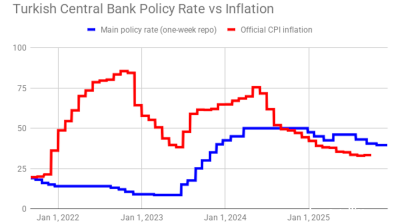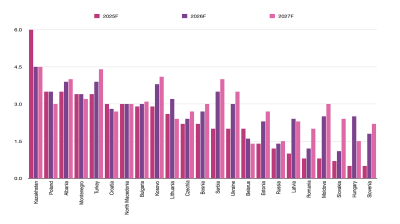Hungary's economy remained in recession in Q2, as GDP fell 0.3% q/q and 2.4% (chart) on an annual basis, the statistics office KSH said in a preliminary reading on August 16. The fourth consecutive quarterly contraction is the longest since KSH began using its current methodology in 1995.
The annualised data was the weakest since the end of 2020. The workday-adjusted GDP fell 2.3% y/y. The data significantly missed projections, as analysts predicted a 1.3% y/y decline and a 0.3% growth on a quarterly basis.
In the first half, GDP fell 1.7% y/y.
On an annual basis, the Hungarian economy was the third-worst performer in the European Union, but on a quarterly basis the picture is slightly better, with five countries behind Hungary.
The preliminary report does not include a breakdown of performance by sectors, but KSH in a short note said that industry and market-based services, mainly transport, warehousing, and trade, contributed to the decline, while the decline was moderated by the performance of agriculture.
Following the data release, analysts have cut their growth projections and said that the government’s 1.5% GDP target looks increasingly unrealistic and recession for the full year seems inevitable.
Monthly data from industry, construction and retail has foreshadowed a sharp contraction, but the performance of agriculture, healthcare, and some market services could not offset the decline, Erste analyst Janos Nagy commented. The second reading, due out on September 1, will probably show the underperformance of market-based services.
ING Bank also highlighted the weaker-than-expected growth of the service sector, with private healthcare being one of the few exceptions. Agriculture has probably posted good numbers, but that was not enough to lift Hungary out of technical recession in Q2 as many had expected. The bank revised its forecast to negative growth from 0.2-0.4%.
The finance ministry did not comment on the disappointing Q2 data, rather it stressed what many analysts predict that the economy will return to a growing path in H2, driven by growing real wages and consumption, as consumer prices are falling at a sharp pace from their peak in January, together with expanding industrial output and the improving foreign trade balance with rising exports.
Finance Minister Mihaly Varga signalled earlier that the government may review its deficit targets in September, and many analysts expect that GDP targets could be modified.
Hungary quickly recovered from the pandemic shock, posting a 7.6% growth in 2021, but the economy began to run out of steam starting the second half as the energy crisis kicked in and the government was forced to make corrections in the budget. Spending cuts have led to lower investment and the EU's highest inflation constrained the purchasing power of households, who also faced surging energy bills following the overhaul of household subsidies.
The government blamed the war and the EU sanctions for economic woes, but economists note the pro-cyclical fiscal policy ahead of the 2022 spring elections has caused a textbook boom and bust cycle scenario, which has also led to inflationary pressures that could further stifle a recovery.
Restrictive monetary policy, the collapse of market-based lending and the freezing of EU funds have also amplified Hungary’s economic problems. The country’s high dependence on energy imports and its export-oriented industrial sector makes it vulnerable to unfavourable developments in the external global economic environment.
Data

Turkey's central bank remains cautious, delivers 100bp rate cut
Decision comes on eve of next hearing in trial that could dislodge leadership of opposition CHP party.

Polish retail sales return to solid growth in September
Polish retail sales grew 6.4% year on year in constant prices in September, picking up from a 3.1% y/y rise in August, the statistics office GUS said.

Uzbekistan’s nine-month foreign trade nears $60bn
Export growth of 33% and import expansion of 16% y/y produce $6.4bn deficit.

Hungary’s central bank leaves rates unchanged
National Bank of Hungary expects inflation to fall back into the tolerance band by early 2026, with the 3% target sustainably achievable in early 2027 under the current strict policy settings.



